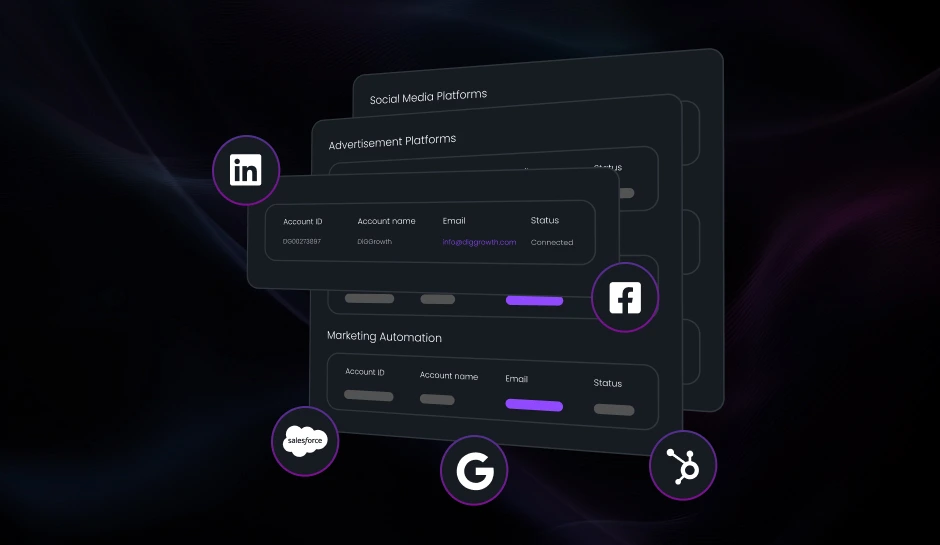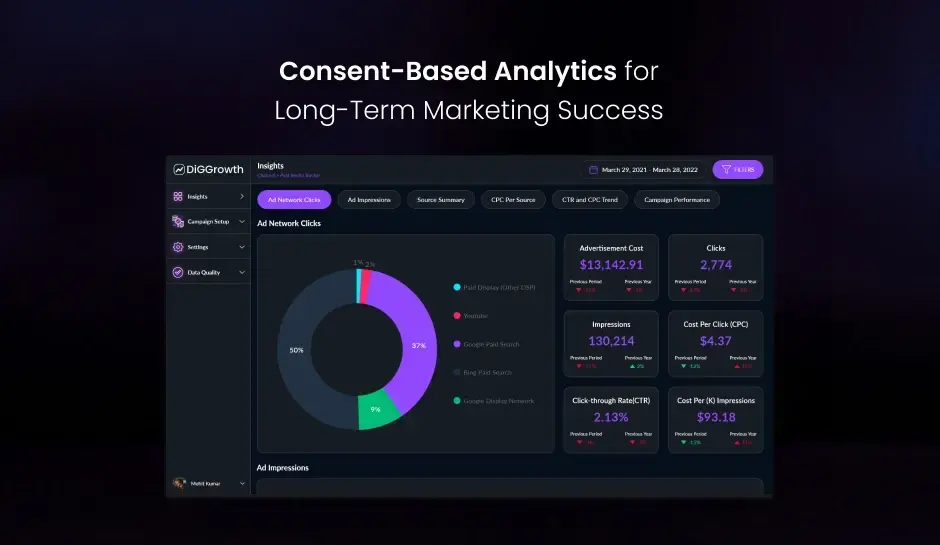
Level Up Your Marketing with Multi-Touch Attribution Solutions
Traditional marketing tools leave you in the dark. Multi-touch attribution solutions shed light on the customer journey, revealing how every interaction – from social media posts to website visits – contributes to conversions. This blog explains how Multi-touch attribution unlocks a deeper understanding of your customer journey and empowers you to optimize campaigns for maximum impact.
Multi-touch attribution is a method by which marketers evaluate the value and contribution of each touchpoint along the customer’s journey to conversion. It offers a comprehensive view of the customer journey, allowing for a more granular assessment of how each interaction contributes to the ultimate goal—a sale, sign-up, or other conversion.
As businesses strive to allocate their marketing budget effectively, MTA stands out as an indispensable tool. It goes beyond traditional models that usually credit a single touchpoint, often the last click, by distributing credit across all interactions that played a role in the decision-making process. This holistic approach enables marketers to understand the true performance of their campaigns and fine-tune their strategies for maximum impact. By incorporating insights into customer experience, marketers can create more personalized, impactful engagements. Unpack the complexities of multi-touch attribution solutions with us and learn how they differ from traditional models, empowering you to transform your marketing efforts into a data-driven success.
The Importance of Attribution in Digital Marketing
Attribution is an essential aspect of digital marketing that allows marketers to understand the impact of their efforts across various customer touchpoints. It is a vital decision-making tool, providing valuable insights into which channels and tactics drive conversions and contribute to sales.
Attribution as a Decision-Making Tool for Marketers
Smart attribution allows marketers to allocate budgets effectively, optimize campaigns in real time, and generate a higher return on investment. By quantifying the success of each marketing touchpoint, multi-touch attribution solutions ensure that resources are invested in the most impactful strategies. This optimization directly influences product strategies, helping businesses understand which marketing efforts resonate most with customers and drive product demand.
Connecting the Dots Between Touchpoints and Conversions
Marketing is a more complex journey, from ad exposure to purchase. The modern customer’s path to conversion is complex, involving multiple devices and channels. Multi-touch attribution solutions bridge the gap between these touchpoints, offering a comprehensive view of the customer journey and highlighting key interactions that lead to conversion.
Aligning Attribution with Business Goals
The ultimate goal of any marketing strategy is to drive business growth. By leveraging multi-touch attribution, marketers can ensure their efforts align with broader business objectives. Attribution data clarifies customer behavior and preferences, allowing brands to tailor their marketing strategies to attract customers, retain them, and increase their lifetime value.
While multi-touch attribution presents a more nuanced and complete understanding of the customer journey, it is important to recognize the limitations of traditional models. Older methods, such as single-touch attribution, need to provide the depth of insight offered by multi-touch frameworks, prompting a shift towards more advanced attribution solutions in digital marketing. By focusing on the end user, these models offer a clearer view of how customers engage, helping brands optimize strategies and improve ROI.
Key Components of Multi-Touch Attribution Solutions
Multi-touch attribution (MTA) solutions offer that granularity by evaluating the impact of each interaction across the entire conversion path. Below are critical elements integral to effective multi-touch attribution.
Assigning Credit Across Touchpoints and Channels
To optimize marketing spend, it is essential to understand which touchpoints contribute most to conversions. Multi-touch attribution solutions must effectively attribute credit to each touchpoint, ensuring an equitable distribution that reflects their true influence on the customer’s decision to convert.
The Role of Data Accuracy and Analysis
The accuracy of MTA solutions hinges on the reliability of the data collected. Clean and precise data underpin robust analysis, enabling marketers to make data-driven decisions. Advanced analytics tools sift through vast datasets, drawing actionable insights that drive campaign optimization and strategic planning.
Pro Tip- When optimizing your marketing spend, prioritize understanding the impact of each touchpoint on conversions with multi-touch attribution solutions. Ensure accurate data analysis to drive strategic planning and campaign optimization for maximum ROI.
Different Types of Multi-Touch Attribution Models
Choosing the most fitting multi-touch attribution model is crucial for marketers seeking a comprehensive view of their campaign performance. Each model type offers a unique perspective on how conversion credit should be distributed across various touchpoints.
Linear Attribution Model
The Linear Attribution Model gives equal credit to each touchpoint throughout the customer journey. It’s a straightforward approach, demonstrating how each interaction contributes to the final conversion without weighting any single touchpoint over another.
Time Decay Attribution Model
As implied by the name, the Time Decay Attribution Model assigns more credit to touchpoints that happen closer in time to the conversion. It’s based on the premise that the more recent interactions are more influential in the decision-making process.
U-Shaped Attribution Model
The U-Shaped Attribution Model, also known as Position-Based Attribution, allocates a larger portion of the credit to the first and last interactions, generally around 40% to each, with the remaining 20% distributed among other touchpoints. This model recognizes the importance of the initiation and completion phases in the buyer’s journey.
W-Shaped Attribution Model
The W-Shaped Attribution Model builds upon the U-shaped approach by adding another key touchpoint—often the opportunity creation stage. In this model, the first interaction, opportunity creation, and last interaction before conversion are each attributed significant credit, typically around 30%, with the remaining 10% spread out across other touchpoints.
Data Collection and Integration in Multi-Touch Attribution
The backbone of any robust multi-touch attribution (MTA) solution lies in its ability to collect comprehensive data and seamlessly integrate this information from various sources. For businesses seeking to understand the intricate web of touchpoints that influence a customer’s decision-making journey, especially in multichannel marketing this step is crucial. Below, we dive into the foundations of data collection and integration in MTA, highlighting the importance of data quality and outlining best practices to ensure actionable insights.
The Importance of Gathering Comprehensive Data
Understanding customer interactions across multiple channels and touchpoints is the key to an effective MTA system. With the full picture of a customer journey, attributions can be accurate and complete. This underscores the necessity of collecting a diverse range of data points — from initial awareness through conversion.
Integrating Disparate Data Sources
Marketers face the challenge of merging data from various sources, such as CRM systems, advertising platforms, web analytics tools, and more. Successful integration requires a consistent and structured approach, ensuring every data source contributes to a unified view of the customer journey.
Ensuring Data Quality and Timeliness
- Data accuracy:
- Data completeness:
- Timely data:
MTA relies on precise data. Any errors in data collection can propagate through to the attribution analysis, leading to incorrect conclusions. Rigorous validation processes are imperative.
Fragmented data can result in blind spots that skew attribution modeling. Collating complete data sets provides a more accurate representation of the customer journey.
The digital marketing landscape is fast-paced, and delayed data can make insights obsolete. Real-time or near-real-time data processing keeps MTA relevant and actionable.
Leveraging Machine Learning and AI in Attribution
Multi-touch attribution solutions are evolving rapidly with advanced technologies like Machine Learning (ML) and Artificial Intelligence (AI) integration. These technologies are revolutionizing how businesses understand and assign value to the myriad touchpoints in a customer’s journey.
Using AI to Predict Credit Allocation
Artificial Intelligence shines by analyzing vast amounts of data to predict the most effective touchpoints in a marketing campaign. By learning from historical data, AI and automation can assign credit to various channels and interactions based on their likelihood of converting leads into customers. This predictive analysis is key to optimizing marketing efforts and ensuring resources are focused on the most impactful areas.
Machine Learning for Refining Attribution Models
Machine Learning algorithms continuously improve multi-touch attribution models by identifying and learning patterns in data. Over time, these models become more refined and accurate, adjusting to new marketing strategies and customer behaviors. This allows for dynamic attribution that aligns closely with real-world interactions and conversions, enabling Corporations like HubSpot to maximize their marketing effectiveness.
Embracing machine learning and AI in multi-touch attribution solutions not only fine-tunes the model’s accuracy but also aids in mapping the customer path with greater sophistication, paving the way for more informed decision-making and strategic marketing investments.
Maximizing Marketing Returns: The Power of Multi-Touch Attribution
One of the most compelling features of multi-touch attribution (MTA) solutions is their ability to measure and optimize the return on investment (ROI) for marketing campaigns. By providing a holistic view of the customer journey, MTA enables marketers to accurately assess which touchpoints contribute to sales and conversions and to what extent. This crucial insight is invaluable for justifying marketing spend and optimizing channel allocation.
Calculating the Return on Investment for Marketing Campaigns
MTA dismantles the complexities of customer interactions across various channels, allowing marketers to pinpoint how each interaction affects the final decision. Businesses can calculate their ROI with greater precision by assigning a value to each touchpoint. This allows for refined budgeting, channeling funds into the most impactful areas, and eliminating or improving underperforming strategies while keeping the audience at the forefront of their marketing efforts.
Using MTA to Justify Marketing Spend
When stakeholders demand accountability for every dollar spent, MTA provides evidence to support marketing strategies. By linking marketing efforts directly to revenue, MTA solutions empower marketing teams to validate their investments. This clarity ensures that marketing budgets are maintained or expanded confidently, supporting continued growth and experimentation.
Optimizing Channel Allocation Based on ROI Insights
Insights from multi-touch attribution allow for agile channel optimization. Marketers can dynamically reallocate the budget by understanding which channels deliver the highest ROI to enhance overall campaign performance. Furthermore, they can also forecast future trends and anticipate shifts in consumer behavior, staying one step ahead in the marketing landscape. This proactive approach to channel allocation ensures that marketing efforts are more successful and cost-efficient for each individual campaign.
Best Practices for Implementing Multi-Touch Attribution Solutions
Embracing multi-touch attribution (MTA) is a transformative step for savvy digital marketers seeking to understand the true impact of their campaigns. To ensure the successful implementation of MTA, follow these industry-tested best practices, which will help you maximize the benefits of your MTA efforts.
Step-By-Step Guide for Setting up MTA
- Define your goals:
- Determine your attribution model:
- Collect and unify your data:
- Test and validate:
- Analyze and optimize:
Understand your goals with MTA and set clear, measurable objectives.
Choose one that suits your business needs and marketing strategy.
Ensure data from all touchpoints is collected and integrated effectively for a holistic view.
Run tests to validate the accuracy of your attribution model and make necessary adjustments before full-scale implementation.
Regularly analyze the results to optimize campaigns and refine your approach for better accuracy over time.
Training Teams on MTA Tools and Approach
Effective utilization of MTA tools requires comprehensive training and an understanding of the MTA approach. Make sure to:
- Invest in education:
- Encourage collaboration:
- Focus on actionable insights:
Provide training sessions for team members responsible for marketing analytics and campaign management.
Break down silos between departments to ensure a unified approach to applying MTA insights across the organization.
Train teams to identify and act on MTA insights that can directly influence future marketing efforts.
Staying Agile and Adapting to Feedback
Agility is key to capitalizing on MTA, markets and technologies continually evolve. To stay ahead:
- Monitor metrics consistently:
- Adapt your strategy:
- Iterate continuously:
Keep a close eye on performance indicators to swiftly react to changes or trends.
Be willing to modify your marketing strategy based on the real-time insights provided by your MTA solution.
Review and refine your attribution models regularly to keep pace with shifts in consumer behavior and technological advancements.
DiGGrowth Case Study: Empowering a Finance Company’s Establishment
Introduction
- The finance industry is highly competitive, requiring strategic marketing approaches to establish a strong presence.
- DiGGrowth’s multi-touch attribution (MTA) solutions offer insights into customer behavior across various touchpoints, aiding in effective marketing strategies.
Challenges Faced
- The finance company struggled to establish itself amidst fierce competition.
- The need for more understanding of customer interactions helped targeted marketing efforts and ROI optimization.
DiGGrowth Implementation
- DiGGrowth implemented a comprehensive MTA model to analyze customer interactions across channels, including online ads, email campaigns, and search engine marketing.
- By tracking and attributing credit to each touchpoint, DiGGrowth provided actionable insights into the most effective channels for driving conversions.
Results Achieved
- With DiGGrowth’s insights, the finance company reallocated its marketing budget, focusing on high-performing
channels. - Within six months, the company experienced a remarkable 25% increase in revenue, showcasing the efficacy of DiGGrowth’s data-driven approach.
Future Trends in Multi-Touch Attribution Analytics
As the digital landscape continuously evolves, multi-touch attribution (MTA) solutions must adapt to keep pace with emerging technologies and shifting market dynamics. Staying ahead of the curve is essential for marketers aiming to effectively track and optimize their campaigns in a rapidly changing environment.
Emerging Technologies in MTA
Advancements in technology are set to revolutionize multi-touch attribution. We are likely to witness the rise of improved data processing capabilities that enable real-time attribution and decision-making. Furthermore, integrating blockchain technology may enhance transparency and trust in attribution data, mitigating fraud and ensuring accuracy for the target market.
The Evolution of Customer Privacy and Its Impact on Attribution
The growing emphasis on customer privacy, driven by regulations such as GDPR and CCPA, is significantly impacting the future of MTA. As privacy requirements become more stringent, attribution models must pivot towards privacy-preserving methods, utilizing anonymized data and ensuring compliance without sacrificing analytical depth.
Predicted Shifts in Multi-Touch Attribution Strategies
Looking ahead, we can anticipate a shift towards more holistic attribution strategies encompassing digital touchpoints and offline interactions, creating a comprehensive view of the customer journey. The convergence of attribution with other analytics solutions will offer a more granular understanding of cross-channel performance and customer behavior through factor analysis.
- Adoption of Cross-Device Attribution:
- Greater Emphasis on Predictive Analytics:
- Enhanced Customization and Flexibility:
As consumers continue to use multiple devices, MTA solutions that can seamlessly track and integrate data across these touchpoints will become paramount.
By harnessing the power of predictive modeling, MTA tools can forecast future consumer actions and the potential impact of marketing efforts, allowing for more proactive campaign management.
Marketers will demand MTA platforms tailored to their specific needs, accommodating unique business goals and evolving measurement parameters.
Choosing the Right Multi-Touch Attribution Software
Identifying the perfect multi-touch attribution (MTA) software is crucial for marketers who want to understand customer interactions across various touchpoints and assign value accurately. It’s not just about having robust technology—it’s about finding a solution that aligns with your business goals, marketing strategies, and the unique customer paths within your industry, especially in terms of lead generation.
Features to Look for in MTA Software
The fast-paced digital marketing arena demands that your MTA solution stays ahead of the curve. Below are key features you should expect:
- User-Friendly Interface:
- Data Integration Capabilities:
- Real-Time Analytics:
- Advanced Machine Learning Algorithms:
- Customization Flexibility:
- Comprehensive Reporting Tools:
- Privacy Compliance:
An intuitive dashboard that provides a comprehensive view of the customer journey and simplifies complex data analysis.
Seamless integration with various data sources and marketing platforms to ensure a holistic view of the attribution path.
The ability to monitor campaigns and touchpoints in real-time for agile decision-making.
A system that evolves and learns from data to provide more accurate attribution as it processes more interactions.
Options to tailor the solution to your business needs, objectives, and key performance indicators (KPIs).
Detailed yet digestible reports that can inform strategy and prove ROI effectively.
Strong data privacy practices that align with regulations such as GDPR and CCPA.
Vendor Comparison and Selection Criteria
Choosing an MTA vendor can be overwhelming. Focus on these primary selection criteria:
- Reputation and Reliability:
- Integration Ecosystem:
- Support and Training:
- Cost Efficiency:
- Future Proofing:
Customer reviews and testimonials support the provider’s track record in the market.
The ability of the software to seamlessly integrate with your existing marketing technology stack.
Ongoing customer support and comprehensive training resources for your team.
A pricing model that provides value for money and aligns with your budget constraints.
A vendor that continually innovates and updates its software to address emerging trends and technologies.
Key Takeaways
- Understanding Attribution’s Role: Multi-Touch Attribution (MTA) offers a granular assessment of customer journeys, which is crucial for effective marketing strategies, particularly when considering search engine results page performance.
- Importance of Data-driven Decisions: Attribution provides actionable insights into channel performance, enabling marketers to allocate budgets effectively.
- Navigating Complexity: MTA bridges the gap between touchpoints, offering a comprehensive view of the customer journey in the digital landscape.
- Aligning Strategy with Goals: By leveraging MTA insights, marketers can ensure their efforts align with broader business objectives, driving growth and customer satisfaction, through effective promotion.
Conclusion
Multi-Touch Attribution (MTA) is vital in modern digital marketing, empowering businesses to understand and optimize customer journeys. By embracing MTA, marketers can make data-driven decisions, allocate resources effectively, and drive business growth. As the digital landscape evolves, staying abreast of emerging trends and leveraging advanced attribution solutions will be key to maintaining a competitive edge and achieving marketing success.
For more information on how DiGGrowth can help optimize your marketing strategies with Multi-Touch Attribution Talk to Us!
We would love to meet you just write to us at info@diggrowth.com and we’ll get back to you.
Ready to get started?
Increase your marketing ROI by 30% with custom dashboards & reports that present a clear picture of marketing effectiveness
Start Free Trial
Experience Premium Marketing Analytics At Budget-Friendly Pricing.

Learn how you can accurately measure return on marketing investment.
Additional Resources
Integrating Data from Different Channels for a Holistic View of Your Marketing Performance
Who's your ideal customer? Where do they come...
Read full post postGet Your Channels to Play Nice: Integrated Data for Smarter Marketing
If you’re a savvy marketer, you’re living in...
Read full post postConsent-Based Analytics for Long-Term Marketing Success
As marketers, we want our customers to perceive...
Read full post postFAQ's
MTA is a method marketers use to evaluate the value of each touchpoint in a customer's journey to conversion. It's essential because it provides a comprehensive understanding of how various interactions contribute to the final goal, enabling marketers to optimize their strategies effectively.
Unlike traditional models that credit a single touchpoint, MTA distributes credit across all interactions that play a role in the decision-making process. This holistic approach offers a more accurate representation of campaign performance and helps marketers make data-driven decisions.
Implementing MTA can be challenging due to the complexity of customer journeys and the need for accurate data collection and analysis. Additionally, selecting the right attribution model and integrating various data sources pose significant hurdles for marketers seeking to leverage MTA effectively.
 Shagun Sharma
Shagun Sharma  Sameer Pawar
Sameer Pawar 

